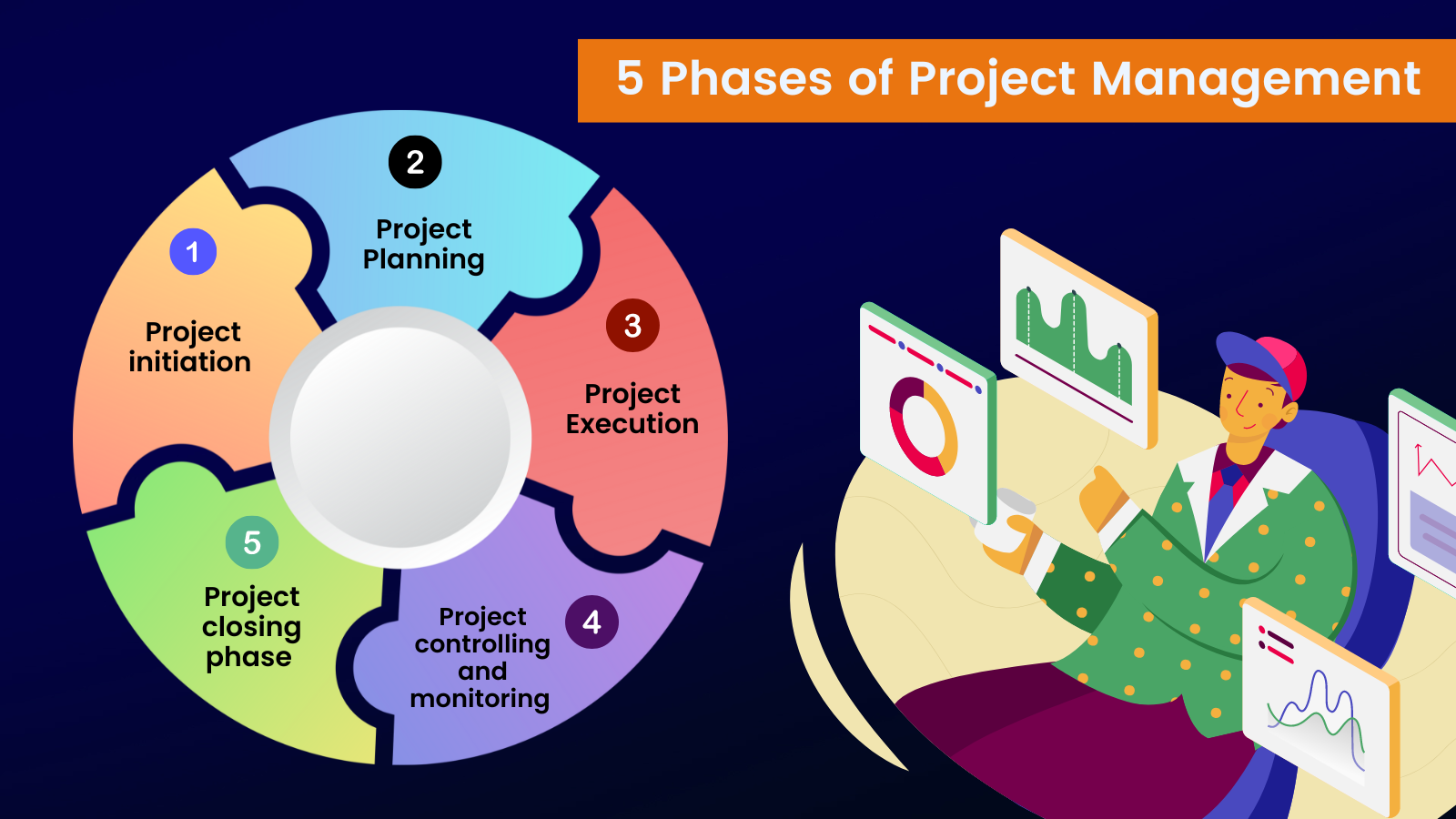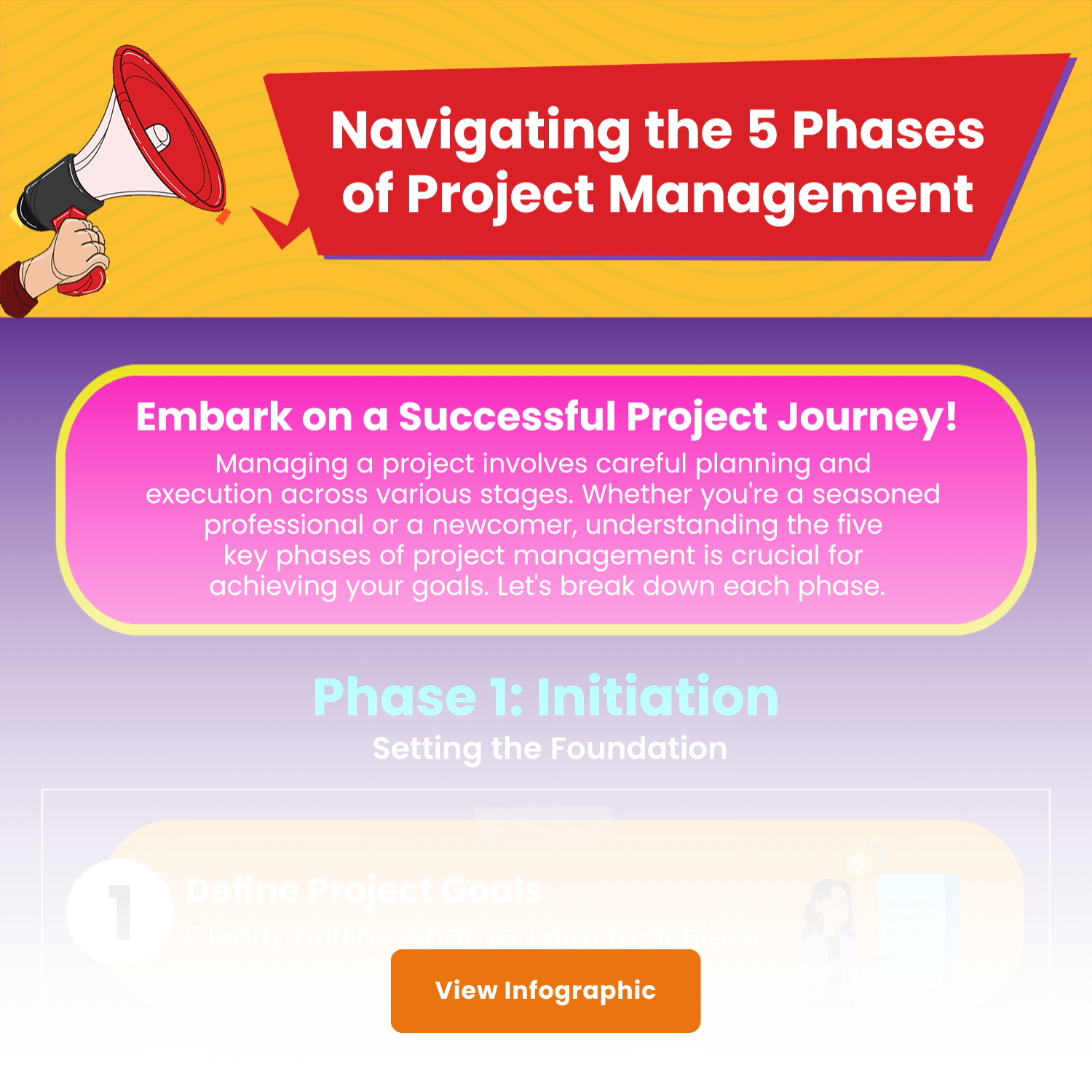
An effective project manager (PM) is the foundation of every successful project. Despite the misconception that project managers are simply responsible for reminding everyone of deadlines and scheduling status meetings, this is not the case.
To perform these tasks effectively, they need to deeply understand the five phases of project management life cycle, which can be executed to perfection. This article will discuss what each of these phases entails and provide tips on how to achieve success.
The five phases of the project management life cycle were developed by the Project Management Institute (PMI) and include project conception, planning, execution, performance monitoring, and closure. Since its founding in 1969, PMI has been the world’s largest nonprofit membership association for project managers. The organization has set standards for managing projects, programs, and portfolios and offers training and certification programs. Project Management Professional (PMP)® certification is the association’s gold standard of certification. In addition to this certification, seven other types of project management certifications are available.
Approximately 80 PMI members worked together to create the text A Guide to the Project Management Book of Knowledge (PMBOK® Guide) to standardize project management information and practices.
With a fifth edition in its current state, the PMBOK® Guide provides an overview of best practices used worldwide for achieving better outcomes. Even though PMBOK® Guide is a standard, it recognizes that every project is different. Using the techniques and phases described in the PMBOK® Guide, PMPs can customize their project to meet its unique requirements.
What is Project Management?
Project management is the process of executing and completing projects. No matter whether it’s a one-time project or an ongoing one, a project manager typically leads it. Although responsibilities vary by industry and business, project managers usually determine the project’s objectives, components, and resources needed to accomplish them.
In different industries or projects, there are different types of project management. For instance, waterfall project management dictates that tasks are completed one after another. In agile project management, deliverables are continuously monitored and improved. Additionally, lean project management focuses on reducing waste in terms of time and resources.
Also Read: Revamp Project Management with No-Code
Demystifying the 5 Phases of Project Management
Effective project management is essential for successfully completing any initiative, whether it be a new product launch or a major organizational change. Managing a project involves a series of interrelated activities that help ensure that the project is successfully completed within the time frame, budget, & to the desired quality standards.

To achieve success in project management, it is common for project managers to follow a set of predefined phases that guide the project from start to finish. In this article, we will delve into the five phases of project management and share valuable tips on executing each phase efficiently. Whether you are an experienced project manager or a beginner, grasping these stages of project management is crucial for delivering successful projects.
1. Project initiation
When embarking on a new project, it’s crucial to determine if it’s worth pursuing, and the initiation phase helps you do just that. During this phase, you’ll define the project’s objectives, identify the problems it aims to solve and establish the desired outcomes. Also, you’ll determine how to measure success and identify the internal and external stakeholders that need involvement. Essentially, the initiation phase sets the foundation for the entire project and ensures everyone involved is aligned on the project’s purpose and objectives. A simple way to describe the initial stages of project management is that it establishes meaningful goals from abstract ideas.
A framework for setting SMART goals
Consider using the SMART goal framework to identify your project’s goals. The acronym SMART stands for:
- S – Specific: Clearly define and unambiguously state your objectives.
- M – Measurable: Your progress towards your goals should be measured using specific criteria.
- A – Attainable: Do not set unrealistic goals.
- R – Relevant: Objectives should be realistic and achievable within your business.
- T – Time-bound: There should be a clear beginning and end date for your goals.
Let’s take the example of a car manufacturer developing an electric vehicle. The initiation phase will not include making decisions about the vehicle’s design, capacity, or battery power. There is only one certainty: an electric vehicle will be developed within the budget and timeframe provided.
Also Read: Agile Product Management Techniques for Faster Time to Market
2. Project planning
You will establish clear goals using a project roadmap during the project planning stage of project management. Goal setting can be accomplished in several different ways. The three common project planning strategies are SMART goals, CLEAR goals, and objectives and key results (OKRs).
Here are a few different ways to set those goals:
- SMART Goals: These are like your detailed packing list. Specific, Measurable, Attainable, Relevant, and Time-bound. They make it clear exactly what you want to achieve, how you’ll measure success, and by when.
- CLEAR Goals: Think of these as the fun, collaborative part of planning your route. Collaborative, Limited, Emotional, Appreciable, and Refinable. This approach focuses on working together as a team to set realistic goals that everyone feels passionate about achieving. They can also be easily adjusted along the way if needed.
- OKRs (Objectives and Key Results): This is like having a big vision for your trip and then figuring out the specific stops you need to make to get there. Objectives are the big picture goals, and Key Results are the measurable achievements that show you’re on the right track. This approach helps everyone in the organization understand the overall goal and how their work contributes to it.
No matter which method you choose, your project plan should be like a detailed itinerary for your trip. It should break down your goals into smaller, manageable steps called milestones. It should also include deadlines for each step, so everyone knows when things need to be done. A good plan will also consider different scenarios, like unexpected traffic jams (project risks) and detours (changes that need to be made). Having a communication strategy helps everyone stay on the same page, and a contingency plan ensures you’re prepared for anything that comes your way.
When it comes to strategizing for this stage, there are various approaches you can adopt. One effective method is agile project management, which optimizes the use of development resources and ensures client requirements are met.

3. Project execution
During the execution phase of a project, the team focuses on achieving the established objectives through collaboration and teamwork. To streamline the process, tasks can be assigned using a project management tool, allowing for easy resource access and communication. Visualization tools like timeline software can be used to track progress. Lastly, a clear methodology for tracking success should be prepared to ensure everyone is on the same page.
Also Read: Project Management Hacks 101: Handbook for Assured Success
You may wish to track specific performance indicators or set post-campaign objectives.
The project schedule should be updated as needed to accommodate changing deadlines and workloads, and dependencies should be closed once they have been met. To meet a deadline, make sure your team’s schedule is organized by priority. To ensure that the project is on track and deliverables are met, checking in with team members frequently is a good idea.
Despite schedule fluctuations, it is important to stay as close to the original timeline of phases of project management as possible to avoid scope creep. To put it another way, do not expand the scope of the project beyond its original intent.

4. Project controlling and monitoring
To ensure that project objectives and deliverables are met, the project monitoring and control phase runs concurrently with the project execution phase.
Using Critical Success Factors (CSF) and Key Performance Indicators (KPI), you can ensure that no one deviates from the original plan.
It is also the manager’s responsibility to quantitatively track effort and cost during the monitoring phase of project management. Keeping track of the project ensures that the project remains within budget and provides helpful information for future projects.
Also Read: Project Management Simplified for Non-Project Managers
5. Project closing phase
As a project nears completion, closure becomes a critical phase. This phase involves finalizing project deliverables, conducting a review of project results, and celebrating project achievements. The following steps are covered in this category:
- Delivering the deliverables
- The release of staff and resources
- Keeping all relevant project documents in a safe place or transferring them to the project team
- Contract cancellations with suppliers
- Ensure that all project activities are completed
- Finalizing the project budget and report
- Handover
After closure, you can conduct a post-implementation project review (sometimes called a ‘postmortem’ meeting). This is an opportunity to evaluate what worked well and what didn’t. Understanding failures, if any, can help you learn lessons and improve future projects.
Streamlining Project Management with No-Code Development
No-code solutions offer many advantages across the five phases of project management. During the initiation phase, no-code tools enable rapid prototyping, allowing stakeholders to quickly create prototypes and visualize their ideas before significantly investing time and resources.
Additionally, no-code development facilitates early user involvement, providing a platform for gathering feedback and refining project requirements, ensuring alignment with user needs immediately.
In the planning phase, no-code platforms provide visual interfaces that simplify the creation of flowcharts, diagrams, and interactive mockups. This visual planning capability aids project managers in visualizing and mapping project workflows and processes, enhancing the overall planning and coordination efforts.
No-code tools assist in efficient resource allocation by offering features for task assignment, timeline tracking, and identifying potential bottlenecks. These functionalities enable project managers to optimize resource utilization and ensure smooth execution.
Conclusion
In the present day, cloud-based project management software is a common method of storing all project-related documents.
When a project is divided into multiple phases, it appears more predictable. In addition, it provides a framework for planning and executing operations. In the past, spreadsheets and Post-it notes sufficed for project management. However, the requirements of digital project management have changed completely.
Planning, organizing, and tracking projects require the right tools. To simplify the project management phases for each project, you need online project management software.
Quixy offers a robust platform that supports various phases of project management, streamlining processes and enhancing efficiency.
Experience the benefits of Quixy today and simplify your project management workflow.
Frequently Asked Questions (FAQs)
Q. What are the five-phase lifecycle of Project Management?
The five phases of project management are initiation, planning, execution, monitoring and control, and closure.
Q. What is the Project Life Cycle?
The project life cycle refers to the series of phases of project management that a project goes through from its initiation to its closure. It includes the five phases of project management: initiation, planning, execution, monitoring and control, and closure. The project management life cycle phases help in providing structure and guidance to project management by dividing the project into manageable phases with specific objectives and deliverables. It also allows project managers to identify and address potential challenges and risks at each phase, which can improve project outcomes and increase the likelihood of project success.
Q. What are the challenges faced during these phases of project management?
Common challenges of project management include poor communication, scope creep, resource constraints, schedule delays, and stakeholder conflicts. Effective project management techniques and strategies can help mitigate these challenges.
Q. How long do the project management phases typically last?
The duration of the particular phase can vary depending on the project’s complexity, size, and timeline. Initiation and planning phases are typically shorter, while execution and monitoring phases can span the majority of the project’s timeline. The closure phase duration depends on the project’s specific requirements.
Q. What is the purpose of the project planning phase?
The planning phase involves developing a comprehensive project plan, which includes defining project deliverables, creating a work breakdown structure, estimating resources and costs, scheduling activities, and identifying potential risks.
Q. What are some tips for project managers for efficient output?
Project managers can effectively manage their projects by following these tips:
1. Define clear project goals and objectives
2. Create a comprehensive project plan
3. Communicate effectively
4. Build a strong team
5. Monitor progress and adjust as needed
6. Manage risks
7. Use project management software
8. Celebrate milestones and successes
Also, no-code tools like Quixy can help managers align their work to maximize efficiency. By following these tips, project managers can effectively manage their projects and increase the likelihood of project success. Also for better insight you can read our comprehensive blog!
Q. What is the purpose of the project management phases?
The purpose of project management phases is to provide a systematic approach to guide projects from initiation to completion. Each phase serves a specific purpose in the project lifecycle, ensuring that key activities and deliverables are properly addressed. These phases help in defining project objectives, planning and organizing resources, executing tasks, monitoring progress, and ultimately closing the project. By following these phases, project managers can maintain control, enhance communication, manage risks, and achieve successful outcomes within the defined scope, time, and budget constraints.
Subscribe
Login
Please login to comment
0 Comments
Oldest















